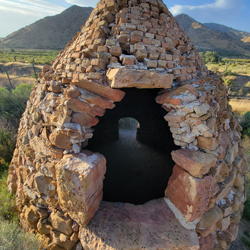


Hype:
The Morrison Charcoal Ovens near Leamington, Utah, offer a fascinating glimpse into the region's 19th-century industrial history. Built from local stone, these well-preserved ovens were essential for producing charcoal used in metal smelting, including at the nearby Ibex Smelter. Though their exact operational dates are unclear, the ovens' use likely ceased when the smelter closed in the late 1800s. Today, the ovens stand as striking remnants of a bygone era, set against the picturesque backdrop of Wood Canyon. Visitors can explore these unique structures and imagine the sounds of bustling workers and wagons that once filled the area.
These charcoal ovens are evidence of a historic man using natural resources. Reminders, which once upon a time, formed the basis of a man’s industrial enterprise. In 1882 that man, George Morrison, hired Nicholas Paul to build four charcoal ovens. Records indicate he was aided by Ole Hans Jacobson and Herman Lundahl. Records also indicate that Christian Overson at one time was in charge of operations.
Wood in mountain canyons to the East was cut into four foot logs, put on mules and horses and hauled to the mouth of the canyon (one of which still has the name of Wood Canyon). Each mule carried approximately one-fourth cord of wood. Young 18 year old Mathias Caeb Dutson made three such trips each day. Total for the day, three cords. The wood was then brought to the ovens by wagon or cart. Records indicate that John Carson and Louis Nielson and other men from the area helped cut and haul the wood and fire the charcoal ovens.
The wood was put through the charge door (the higher window), stacked on end, around and above a wooden fire place which had been built in the center of the oven, filled with chips and wood shavings to provide tinder for the later fire. The wood continued to be stacked until the oven was full (about 25 cords). A long torch was pushed through to the tinder box to light a fire. The burning fire’s oxygen supply was controlled by placing or removing rocks in the two rows of holes, which can be seen around the base of the ovens. Control of the burning wood was determined by the color of the smoke. After six to eight days all the air was shut off, smothering the fire. The ovens and wood were then let cool. The charcoal was removed from the ovens and sold.
The charcoal was used by smelters in making steel. It was also used as insulation to keep foods an even temperature. As charcoal burns with a hot, smokeless flame, it was used on trains and other places for cooking. It was also used by blacksmiths in their forges.
Exactly how long the ovens were used, the record is not clear. It seems their use overlapped one year the establishment of the Ibex Smelter (1895) two miles to the northwest. The smelter closed after one year of operation, because of lack of ore. This probably ended the use of charcoal ovens. Standing inside the oven or outside looking to the top of Wood Canyon, one can almost hear the sound of axes, of men and mules, wagons and trains. The sounds of history are silently heard in our minds as we go back to once upon a time.
Time:
Fees: None
Recommended Ages:
 | 0-3 |
 | 4-11 |
 | 12-19 |
 | 20-49 |
 | 50-69 |
 | 70+ |
Recommended Months to Visit:
| Jan |
| Feb |
| Mar |
| Apr |
| May |
| Jun |
| Jul |
| Aug |
| Sep |
| Oct |
| Nov |
| Dec |
By Jeremy Dye
Jeremy Dye, Tara Dye, Savannah Dye, Madilyn Dye, Cooper Dye,
On our way home from Topaz Mountain, we stopped and took a few pictures of the pioneer charcoal kilns that were on the side of the road.